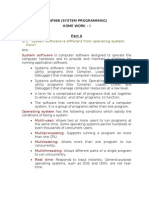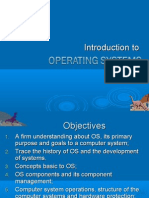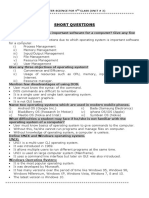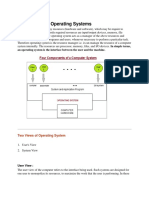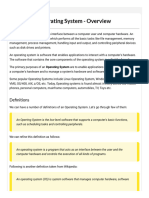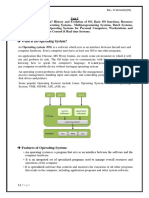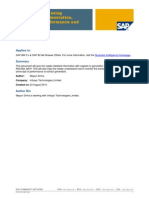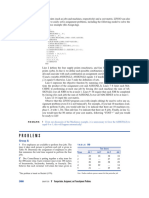Notes
Notes
Uploaded by
gumlamohit7Copyright:
Available Formats
Notes
Notes
Uploaded by
gumlamohit7Copyright
Available Formats
Share this document
Did you find this document useful?
Is this content inappropriate?
Copyright:
Available Formats
Notes
Notes
Uploaded by
gumlamohit7Copyright:
Available Formats
Q: what is Operating System? What are its type?
Ans: An operating system (OS) is system software that manages computer hardware, software
resources, and provides common services for computer programs.
It control the overall processing of a computer.
Operating System is also known as Platform as It work is a mediator between User and System
so that they can interact.
For Eq: windows, DOS(disk operating system), Linux, UNIX, MAC etc
Type of operating System
Single-user, single task - As the name implies, this operating system is designed to manage the
computer so that one user can effectively do one thing at a time. The DOS is a good example of a
modern single-user, single-task operating system as it can perform only one task at a time and only
one user is allowed to perform its task.
Single-user, multi-tasking - This is the type of operating system most people use on their desktop
and laptop computers today. Microsoft's Windows and Apple's MacOS platforms are both examples
of operating systems that will let a single user have several programs in operation at the same time.
For example, it's entirely possible for a Windows user to be writing a note in a word processor while
downloading a file from the Internet while printing the text of an e-mail message.
Multi-user , Multitasking - A multi-user operating system allows many different users to take
advantage of the computer's resources simultaneously. The operating system must make sure that
the requirements of the various users are balanced, and that each of the programs they are using has
sufficient and separate resources so that a problem with one user doesn't affect the entire
community of users. Unix, VMS and mainframe operating systems, such as MVS, are examples of
multi-user operating systems.
Real-time operating system (RTOS) - Real-time operating systems are used to control
machinery, scientific instruments and industrial systems. An RTOS typically has very little user-
interface capability, and no end-user utilities, since the system will be a "sealed box" when delivered
for use. A very important part of an RTOS is managing the resources of the computer so that a
particular operation executes in precisely the same amount of time, every time it occurs. In a complex
machine, having a part move more quickly just because system resources are available may be just as
catastrophic as having it not move at all because the system is busy.
Batch operating system: The users of a batch operating system do not interact with the
computer directly. Each user prepares his job on an off-line device like punch cards and submits it to
the computer operator. To speed up processing, jobs with similar needs are batched together and run
as a group. The programmers leave their programs with the operator and the operator then sorts the
programs with similar requirements into batches.
The problems with Batch Systems are as follows −
Lack of interaction between the user and the job.
CPU is often idle, because the speed of the mechanical I/O devices is slower than the
CPU.
Difficult to provide the desired priority.
Q: What are the different functions of operating System
Ans: Operating System supports all the basic functions of the computer and in general responsible for
smoothing function of a system.
The functions of operating systems are as described below:
i) I/O Management: OS manages I/O devices and makes the I/O process effective. OS accepts the
input from the input device, stores it in the main memory, ask the CPU to process it and finally
provides the result to the output devices for output.
ii) Command Interpreter:
Command interpreter is one of the part of operating system which reads the commands that user
types in at a terminal, interprets them and translate them into a detailed set of instructions that the
computer hardware can understand. It varies widely from one OS to other OS. Every OS must provide
command interpreter for its operation.
iii) Memory Management:
Memory is the large array of words or bytes, each with its own address. When user requests CPU for
read/write operation, OS determines the amount of memory required for the program instructions
and data. Then, OS allocates required memory to load the program and data into RAM. When
program terminates its memory area is free and the same memory area is allocated for other
programs.
iv) Process Management:
OS finds the status of processor and processes, chooses a job, chooses processer in the job, allocates
the processor to the process and frees the processor when the process is executed.
v) Time Sharing:
OS manages the time of CPU. The kernel OS checks frequency for other processes requesting CPU
time. Time-sharing checks for CPU request from higher priority processes that are made every 10
milliseconds. When two or more processes at the same priority level are competing for the CPU time,
CPU time is sliced into segments, defined by time slice and passed from process to process in a round
robin fashion, preventing a single process from monopolizing the CPU until it blocks or terminates.
Process1(A)
Process1(A)
B2 A2 C1 B1 A1 Process2(B)
Process2(B)
Process3(C)
Process3(C)
Input time sharing output
vi) Security:
OS makes sure that only authorized users get access to the computer and its data and the users only
do things they are authorized to do.
VII) Virtual Storage:
If there are programs larger than main memory (RAM) of the computer, OS uses the reserved space in
the secondary memory which is termed as virtual memory. It makes the execution of larger program
(than RAM) possible but at the same times the operation becomes slower.
viii)Managing Resources: Programs that manage the resources of a computer such as the printer,
mouse, keyboard, memory and monitor.
ix) Providing User Interface: Graphical user interface (GUI) is something developers create to allow
users to easily click something without having to understand how or why they clicked an icon. Each
icon on a desktop represents code linking to the spot in which the icon represents. It makes it very
easy for uneducated users.
x) Running Applications, is the ability to run an application such as Word processor by locating it and
loading it into the primary memory. Most operating systems can multitask by running many
applications at once.
xi) Support for built-in Utility Programs: This is the program that find and fixes errors in the operating
system.
You might also like
- Fundamentals of Cyber Security 2Document52 pagesFundamentals of Cyber Security 2fayyadmuhammad45No ratings yet
- Com311 HND1 2020 - 2021-1Document31 pagesCom311 HND1 2020 - 2021-1Aremu RidwanNo ratings yet
- Chapter - 5 Operating SystemDocument6 pagesChapter - 5 Operating SystemAshish SharmaNo ratings yet
- Globe Sprinkler CompanyDocument20 pagesGlobe Sprinkler CompanyWinard WantogNo ratings yet
- Heat Conduction Lab ReportDocument3 pagesHeat Conduction Lab ReportJohnConor96% (24)
- Cosc 0120 Lec I, Lec IiDocument18 pagesCosc 0120 Lec I, Lec Iikawiragitonga17No ratings yet
- OS Module 1-ADocument75 pagesOS Module 1-ALanie ArcoNo ratings yet
- HW1A3803 (368) Sys Prog (24 Last Date)Document8 pagesHW1A3803 (368) Sys Prog (24 Last Date)Surendra Singh ChauhanNo ratings yet
- Operating Systems: Presented byDocument42 pagesOperating Systems: Presented byneverahulNo ratings yet
- Operating System - MaterialDocument69 pagesOperating System - MaterialAnil KumarNo ratings yet
- Operating SystemDocument8 pagesOperating Systemvikram_5889100% (3)
- ch1 OS G12 Week1Document9 pagesch1 OS G12 Week1s.abdulrehman2020No ratings yet
- Introduction of Operating SystemDocument21 pagesIntroduction of Operating SystemVaishnavi RajputNo ratings yet
- Basics of OSDocument22 pagesBasics of OSCherryNo ratings yet
- Today's Topic: We Will Learn: Introduction To Operating SystemsDocument18 pagesToday's Topic: We Will Learn: Introduction To Operating SystemsRashmitaba JadejaNo ratings yet
- Operating SystemDocument24 pagesOperating SystemAssini HussainNo ratings yet
- Os 1Document51 pagesOs 1api-19975941No ratings yet
- Short Questions: Computer Science For 9 Class (Unit # 2)Document5 pagesShort Questions: Computer Science For 9 Class (Unit # 2)Yasir MehmoodNo ratings yet
- Over View: Overview of Operating SystemsDocument54 pagesOver View: Overview of Operating Systemstayyab shamiNo ratings yet
- COM 311 - Operating Systems Week 1-5Document19 pagesCOM 311 - Operating Systems Week 1-5progiestudioNo ratings yet
- Assignment: ITC-LabDocument6 pagesAssignment: ITC-LabR!0No ratings yet
- Ii Unit OsDocument25 pagesIi Unit OsNareshkumarSettiNo ratings yet
- Operting System (OS)Document3 pagesOperting System (OS)acorpuz_4No ratings yet
- Introduction To Operating Systems PDFDocument67 pagesIntroduction To Operating Systems PDFVenkataMurali KrishnaNo ratings yet
- Operating System: MSIT (Master of Science in Information Technology)Document9 pagesOperating System: MSIT (Master of Science in Information Technology)nairdapunk100No ratings yet
- OS Unit 1Document9 pagesOS Unit 1Rama Devi ChNo ratings yet
- Introduction To OS Lecture 2Document54 pagesIntroduction To OS Lecture 2Abhinay YadavNo ratings yet
- Types of SchedulerDocument5 pagesTypes of Schedulervikasrana1991No ratings yet
- OS Unit 1 NotesDocument29 pagesOS Unit 1 Notesrh11092004No ratings yet
- Os Unit IDocument29 pagesOs Unit IswapnaNo ratings yet
- Chap 1 PDFDocument6 pagesChap 1 PDFAyesha TahirNo ratings yet
- Introduction To Operating SystemsDocument9 pagesIntroduction To Operating Systemsyukikitazawa03No ratings yet
- OS Week2 Recitation1 AnswersDocument5 pagesOS Week2 Recitation1 AnswersMonem Shahreer LaptopNo ratings yet
- Chapter-1: Introduction Part-1Document12 pagesChapter-1: Introduction Part-1amir nabilNo ratings yet
- Objectives of Operating System: 1.convenienceDocument6 pagesObjectives of Operating System: 1.conveniencemaryamnasir72001No ratings yet
- Introduction To Operating SystemsDocument72 pagesIntroduction To Operating Systemspriya sharmaNo ratings yet
- COS 331 Operating System2 LectureNotes 2023Document70 pagesCOS 331 Operating System2 LectureNotes 2023eze.pleasant001No ratings yet
- CBSE TutsDocument10 pagesCBSE TutsbeakraamNo ratings yet
- Operating Systems11-9-07 BBA 3 RD SEMDocument19 pagesOperating Systems11-9-07 BBA 3 RD SEMinternationaldegreecollegeNo ratings yet
- Operating System CSCDocument46 pagesOperating System CSCAzeez AdegbiteNo ratings yet
- Operating SystemDocument132 pagesOperating SystemIndumathy ParanthamanNo ratings yet
- How Operating System WorksDocument21 pagesHow Operating System WorksJeffrey Abadesa EsmundoNo ratings yet
- Types of Operating SystemsDocument7 pagesTypes of Operating Systemspritika86No ratings yet
- Operating System - OverviewDocument6 pagesOperating System - OverviewVaibhav PearsonNo ratings yet
- Prof. B. I. Khodanpur HOD - Dept. of CSE R. V. College of EngineeringDocument23 pagesProf. B. I. Khodanpur HOD - Dept. of CSE R. V. College of EngineeringKavin ArsenalonaNo ratings yet
- Operating SystemDocument57 pagesOperating SystemNitika SahNo ratings yet
- Unit1 - Introduction To OSDocument44 pagesUnit1 - Introduction To OSpavankalyannerella42No ratings yet
- 01OSDocument76 pages01OSsathwickNo ratings yet
- Purpose Packages Which Are Written To Meet Specific Needs and General - Purpose PackagesDocument42 pagesPurpose Packages Which Are Written To Meet Specific Needs and General - Purpose PackagesLangat Kipkoech GodwinNo ratings yet
- Tutorial 1: Computer Organization and ArchitectureDocument4 pagesTutorial 1: Computer Organization and Architecturesajan gcNo ratings yet
- Unit1 - Introduction To OS1Document59 pagesUnit1 - Introduction To OS1Aditya SharmaNo ratings yet
- Computer SoftwareDocument6 pagesComputer Softwarejbmaina100No ratings yet
- OS Unit-1Document11 pagesOS Unit-1adars251No ratings yet
- CF Notes - Unit 5Document30 pagesCF Notes - Unit 5pearlinsheebaNo ratings yet
- Assignment 2Document24 pagesAssignment 2accord123No ratings yet
- AOS 1-6 CompilationDocument86 pagesAOS 1-6 CompilationALEXANDRA JARANo ratings yet
- Os Guides 1-2Document24 pagesOs Guides 1-2x 4 dNo ratings yet
- CH 7 OS QADocument13 pagesCH 7 OS QAAzhar_QureshiNo ratings yet
- Operating Systems Interview Questions You'll Most Likely Be AskedFrom EverandOperating Systems Interview Questions You'll Most Likely Be AskedNo ratings yet
- Computer Science: Learn about Algorithms, Cybersecurity, Databases, Operating Systems, and Web DesignFrom EverandComputer Science: Learn about Algorithms, Cybersecurity, Databases, Operating Systems, and Web DesignNo ratings yet
- Scheduling RulesDocument31 pagesScheduling RulesDarshana Mayekar100% (1)
- C-Mos FDC (Floppy Disk Controller)Document3 pagesC-Mos FDC (Floppy Disk Controller)Bos QuNo ratings yet
- KATHREIN 80010735v01Document2 pagesKATHREIN 80010735v01Romina VargasNo ratings yet
- TCP & 3 Way Handshake in DetailDocument13 pagesTCP & 3 Way Handshake in DetailshrikantchaturNo ratings yet
- Automation: Fixed Automation. Fixed Automation Is A System in Which The Sequence of ProcessingDocument7 pagesAutomation: Fixed Automation. Fixed Automation Is A System in Which The Sequence of ProcessingBalu ZerofourNo ratings yet
- Query Extracts Using RSCRM - BAPI: Generation, Monitoring, Performance and RestrictionsDocument8 pagesQuery Extracts Using RSCRM - BAPI: Generation, Monitoring, Performance and RestrictionsSidhesh MangleNo ratings yet
- Tutorial From RNODocument2 pagesTutorial From RNOquens884No ratings yet
- IRFAN - Floor Plan - DimDocument1 pageIRFAN - Floor Plan - Dimwanih saqibNo ratings yet
- Test - PetroBowl Set 1 - QuizletDocument31 pagesTest - PetroBowl Set 1 - QuizletMuhammadAnzjaChabbaniIsta'la100% (2)
- Poteins Worksheet AnswersDocument11 pagesPoteins Worksheet AnswersAbishuaNo ratings yet
- Macro and Macro PreprocessorDocument72 pagesMacro and Macro PreprocessorNitin Birari0% (1)
- MA210 Peano Postulates Definitions TheoremsDocument3 pagesMA210 Peano Postulates Definitions Theoremstripper66No ratings yet
- A Model of Traffic Light System by The Application of PLC - Zarizal Eddy - TE228.Z37 2008 PDFDocument28 pagesA Model of Traffic Light System by The Application of PLC - Zarizal Eddy - TE228.Z37 2008 PDFMona AliNo ratings yet
- Doc-20240512-Wa0003 240513 125207Document4 pagesDoc-20240512-Wa0003 240513 125207mohammed galalNo ratings yet
- Session-5.1-Measuring Data Similarity and Dissimilarity - Part-2Document16 pagesSession-5.1-Measuring Data Similarity and Dissimilarity - Part-2minniNo ratings yet
- η= P P P η=97.09 % P P x P P P P: Problem Set No. 4 Transformer EfficiencyDocument6 pagesη= P P P η=97.09 % P P x P P P P: Problem Set No. 4 Transformer EfficiencyGeva GarradoNo ratings yet
- DL803/824 - Year 4 - Final Project Feasibility Study and Requirements Document GuidelinesDocument5 pagesDL803/824 - Year 4 - Final Project Feasibility Study and Requirements Document GuidelinesAnne WrightNo ratings yet
- Informacion Tecnica Valvula Motora Gas de AltaDocument8 pagesInformacion Tecnica Valvula Motora Gas de AltaGuille MVNo ratings yet
- Swagmode CMDSDocument23 pagesSwagmode CMDSmihaicirstoiu883No ratings yet
- Books 3337 0-Trang-2Document3 pagesBooks 3337 0-Trang-2blackpink199567No ratings yet
- Failure Analysis Ti-6al-4v Alloy Pedicle Screw RuptureDocument12 pagesFailure Analysis Ti-6al-4v Alloy Pedicle Screw RupturePaul RosiahNo ratings yet
- Dam 20803Document6 pagesDam 20803Nordiana IdrisNo ratings yet
- ASTM D 4791 STD Test Method For Flat and Elongated Particles in Course AggregateDocument4 pagesASTM D 4791 STD Test Method For Flat and Elongated Particles in Course AggregateILSEN N. DAETNo ratings yet
- Mindtree Company PROJECTDocument16 pagesMindtree Company PROJECTSanjay KuriyaNo ratings yet
- Compiler: by Noor Wali Khan UochDocument11 pagesCompiler: by Noor Wali Khan UochAbdul MateenNo ratings yet
- Aereocon Ii 3404Document6 pagesAereocon Ii 3404Juan Jose MachadoNo ratings yet
- YOLOV10 ExplainedDocument13 pagesYOLOV10 ExplainedSushma MNo ratings yet
- Alternate Propellants For PPS® Hall-Effect Plasma Thruster PDFDocument3 pagesAlternate Propellants For PPS® Hall-Effect Plasma Thruster PDFSirish KamarajugaddaNo ratings yet








